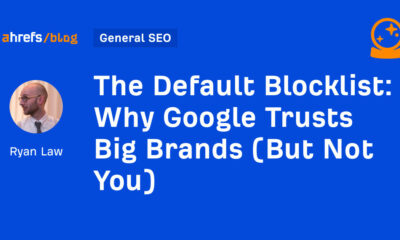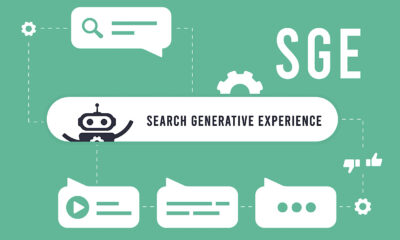MARKETING
Everything Brands Need to Know About the Metaverse

Throughout the COVID-19 pandemic, the internet and social media helped us connect with our coworkers, friends, and loved ones during times of extreme isolation.
But, our web-based lifestyle wasn’t perfect. While you could see and talk to people, interactions still felt distant and impersonal. And, despite having every delivery app at our fingertips, we still missed going outside, exploring the world, and experiencing life to its fullest.
And, for a small — but growing — group of people, that’s where the metaverse came in.
Although metaverses are nothing new, we started hearing more buzz than ever about futuristic virtual reality worlds that could allegedly supplement or expand on our own. As more people began to dive deeper into online gaming, social media, and purchasing VR headsets and accessories, the opportunities of the metaverse gained even more intrigue.
Then, in late of 2021, Mark Zuckerberg shocked the world when he announced the change of his company’s name from Facebook to Meta, adding that it would represent a new evolution of the company’s offerings.
Soon after, Meta’s first metaverse, Horizon Worlds was opened up to anyone with an Oculus or Meta headset. Almost immediately, fans began to refer to this as “the metaverse.”
But, there’s more to the story of the metaverse, and a lot of things you’ll need to know before even asking yourself, “Is investing in a trendy VR world right for my brand?”
In this post, I’ll walk you through what “the metaverse” really is, how you can access all sorts of virtual worlds, and where the brand potential lies in this emerging space.
What is the Metaverse?
Simply put, a metaverse is a universe within a universe. In the VR space, it refers to a VR world where one can explore, meet people, and build alternate realities, appearances, or lifestyles. Although any virtual world can be considered a metaverse, the metaverse often refers to all virtual reality worlds, or Meta’s Horizon Worlds due to the name of the company that owns it.
Does Meta own the Metaverse?
Because Facebook changed its name to Meta, and has a thriving virtual reality platform, you might think the company owns “the metaverse.” In reality –- and virtual reality –- Meta owns one of many metaverses. While Meta’s VR universe is called Meta Horizon Worlds, and is accessed through the company’s Meta VR headsets (formally titled Oculus), there are many other metaverses that early adopters have been using for years.
What happens in the Metaverse?
To explain what happens in the metaverse, we’ll dive into a few types of metaverses and explain what you or your brand can do in each. But, before we dive deeper, here are some definitions you’ll want to remember (and links to more context, courtesy of the HubSpot Blogs and our partners at The Hustle):
Metaverse Terms to Know
- NFT: The much-buzzed-about non-fungible token is a finite or unique digital token, such as digital art, avatar clothing, or VR-based objects, that you can purchase ownership of or stake in. Deep in its blockchain-based coding, there’s a certificate saying that you own or have ownership in the item. (And, yes. There’s much more complexity here than a quick definition can explain.)
- NFT Real-Estate: A non-fungible digital house or piece of land in the metaverse that can be invested in, sold, or even rented out. Buyers get a digital deed or certificate saying they own the real estate.
- Blockchain: A digital ledger of transactions, certificates, and contracts.
- Cryptocurrency: Digital money that you can invest in, sell, or use to purchase products online or in a metaverse. Each type of digital coinage has different values. Popular examples include Bitcoin, Ether, and Dogecoin.
- Open-source: Open to all users for editing and not usually controlled by a brand or single entity. Open-source metaverses can be founded by developers who market and do maintenance on the world, but might not have an obvious company owning them – or customer service when something goes wrong. However, they often allow much more freedom to the users.
Now that you have those quick definitions, let’s take a look at some of the most discussed metaverses out there.
3 Popular Metaverses (And What You Can Do in Each)
While there are many metaverses out there, and we’d love to talk about them all, I’ve focused this post around the three metaverses that are most buzzed about today.
And, because many metaverses have a lot of similar opportunities for brands, I’ll break down brand opportunities (and show you examples of them) in the following section.
Meta Horizon Worlds
Meta’s universe can be accessed by Meta headsets sold by the company (which were previously called Oculus headsets). While this universe can only be accessed by headsets at the moment, Mark Zuckerberg has already discussed trying to expand the experience to contact lenses and even holographic experiences in the far term. Although this metaverse is potentially the most well-known to late adopters and marketers, it is one of the newest major metaverses.
Once you enter Horizon Worlds, you can do almost anything that all earlier metaverses allowed users to do, including:
- Creating your avatar or virtual likeness.
- Talking to other people in the Meta Horizons world.
- Playing games with other Meta Horizons users.
- Asking a Meta support rep (also in the metaverse) questions.
- Teleporting to different locations and experiences within the universe.
- Purchase digital products, such as virtual clothing, from the Horizons Marketplace.
Two key things that make Horizon Worlds different from other major metaverses we’ll discuss below are:
- That it’s centralized, which means it has a known owner who regulates and manages the platform. When you’re in Horizon Worlds, you agree to terms of use and must follow rules or you can be ejected. Meanwhile, other decentralized metaverses have minimal rules, management, and regulations since they usually have initial creators or developers, but no current or obvious owners. In fact, to ensure that users are behaving and learning how to use the Horizon Worlds space, virtual Meta staffers are usually present in each public space:
- You can’t buy land or monetize your brand in Horizon Worlds just yet. While Horizon Worlds does offer a general marketplace, there are no other clear ways to generate revenue on the platform. Meanwhile, on other metaverses that we’ll discuss below, one major goal of users is to buy, sell, or monetize virtual real-estate.
The Sandbox
The Sandbox is one of the oldest decentralized gaming metaverses. Created by gamers around the globe, the platform has gained interest from VR and NFT investors. Once you enter this metaverse, your character can buy and build on land with crypto called MANA. From there, you can sell your land, rent it out, meet people, make connections, and even get paid and buy more land via Sandbox jobs – like architect or landlord. Sandbox, which reminds me of an extreme LEGO universe, is pretty easy to access and create an account on when visiting its website.
Because of its age and credibility in the VR world space, Sandbox is home to many affluent early adopters who already own real estate there, including major gaming companies like Attari and the rapper Snoop Dogg. Additionally, because land plots and the number of SAND tokes that will be created in the game are considered “finite,” the price of the real estate and tokens in this metaverse have skyrocketed in recent years.

Decentraland
One of the most popular metaverses that early adopters have explored and invested in is Decentraland. Created in Argentina by developers Ari Meilich and Esteban Ordano, has been notable for its vast cities and millions of dollars in virtual land and NFT real estate. In fact, a simple Google search reveals that there are already a number of virtual real-estate agencies that specialize in selling NFT land in Decentraland and other metaverses.
As its title would hint, Decentraland is also decentralized, meaning that it has no specific owner or manager and anyone can create in this virtual open platform. Unlike Horizon Worlds, it can only be accessed by personal computers.
A lot of information to consider and unsure where to start? Below is a comparison chart to help.
|
Metaverse Comparison Chart |
|||
|
Name |
Meta Horizon Worlds |
Decetraland |
Sandbox |
|
Years Active |
Last than 1 year |
5 years |
10 years |
|
Estimated Number Users |
300K reported users (unknown daily users) |
300K reported users (18,000 reported daily users) |
1 million reported users (16,000 reported landowners) |
|
Owner |
Meta |
Decentralized (no known owner) |
Decentralized (no known owner) |
|
Availability |
US and Canada for 18+ users only |
Unknown but likely global |
Unknown but likely global |
|
Equipment Needed to Access |
A Meta or Oculus VR headset |
Various VR Headsets or a personal computer |
Various VR Headsets or a personal computer |
|
Cost to Access |
Accessed with an Oculus or Meta headset (prices vary) |
Free to access, but users need a digital wallet with tokens called MANA and LAND to access most experiences. |
Free to access, but users need a digital wallet with tokens called SAND to access most experiences. |
|
How to Get Around |
Teleportation |
You must purchase a virtual car or teleportation device |
You must purchase a virtual car or teleportation device |
|
Gaming Opportunities |
Various free team and individual games |
Users can play and create games that other users can play. |
Users can play and create games that other users can play. |
|
Social interactions with other users |
Yes |
Yes |
Yes |
|
NFT Art/Product Shopping |
Not yet. |
Yes |
Yes |
|
NFT Real Estate |
Not yet. |
Yes |
Yes |
|
Virtual Events |
Yes |
Yes |
Yes |
|
Virtual customer service available? |
Yes |
No |
No |
|
Crypto-currency and USD conversion (as of March 2022) |
You can’t make purchases in Horizon Worlds. |
MANA (1 MANA = $2.69 USD) |
SAND (1 SAND = $3.14 USD) |
|
Price of Land |
You cannot purchase real estate in Horizon Worlds. |
By the end of 2021, 1 plot of land cost over 4,000 MANA or $15,000 USD |
By the end of 2021, 1 plot of land cost more than 3,150 SAND or $9900 USD |
5 Early Opportunities for Brands in the Metaverse [+Examples]
While each virtual world has slightly different experiences, environments, and audience targets associated with it, many of them host a handful of opportunities for brands that want to embrace emerging marketing strategies. Here are just a few ways brands can leverage some of the metaverses that exist today:
1. Inbound Sales and Networking
Today, many marketers and sales reps alike find ourselves messaging, zooming, and emailing prospects to tell them about our product or service. And, rarely, we might go to a networking event or meeting where we talk to prospects face to face.
Now, imagine doing all of this – but digitally with avatars. In almost all metaverses, you can explore a place and talk to other users for free. This means that if you sell or market a B2C product, you could casually discuss the product in conversation, as you would with anyone else you’re networking with, and then tell users where they can learn more. While you still might not be able to send them to a branded experience, virtual shop, or have them click a link to your website just yet, you can still spread the word to multiple people on a more personal level than an email without leaving your seat.
If you work in the VR or metaverse space, you could also leverage sales in a more extreme way by selling NFT items, like art, real estate, or virtual cars. While it seems many virtual salespeople don’t record transactions and post them for the world to see, here’s a video of someone buying a car from a dealership salesman in a metaverse.
If you’re wondering, “Where could I go to ensure I’m talking to the right people?”, one opportunity is attending virtual events, which I’ll discuss next.
2. Virtual Events
While virtual events are still being developed for general businesses on Horizon Worlds, Decentraland, Sandbox, and other virtual worlds host many landowners that are will to rent out their virtual space for events or virtual parties. Similarly, some companies and entrepreneurs have also built their own lands with the goal of using them for events like NFT art shows, conferences, or meetups.
If you can afford to run, host, or even sponsor part of an event, you can gain crypto revenue or awareness from users who are interested in the topic, while also gaining awareness for your product or service.
For example, here’s a video of a TikTok user who attended an Afro Tech conference in a metaverse.
While INBOUND and HubSpot haven’t hosted a conference in a metaverse just yet, we too are embracing the possibility of virtual events by building out a similar platform for INBOUND 2022‘s hybrid attendees. If you’d like to get a virtual conference experience without committing to a metaverses digital currency or platform, consider registering for our event.
If you don’t have the budget for creating virtual events just yet, you can still consider attending, buying a ticket for one, or even speaking at one. While there, you can use it as a networking opportunity to get to know others in your industry or potential prospects who might even buy your product outside of VR.
3. Influencer and Community Marketing
In any metaverse, you could potentially talk to a handful of people at once, while casually mentioning your product or even wearing NFT clothes with your logo. You could also pay people who are familiar with their metaverse or selling in the metaverse to continue to spread the word about your brand or services for you.
But, influencer and community marketing might not just stop there. If you find that your metaverse has an audience of users that are interested in your product, service, or industry, you can work to bring them together – even if you can’t afford or figure out how to schedule a virtual event.
For example, you could host a meetup on your brand’s virtual land or in a free-to-access metaverse space for those who want to chat about topics rated to your industry or product. And, while you’re there, you could just open the door to casual conversation. Or, you could all join a fun game and bond, then get to know each other in a less active space.
Not only will you network, show credibility, and spread the word about your product, but you’ll build a group of people that are interested in your industry, similar topics, or your brand.
4. Owning Branded Locations, Games, Avatar Fashion, and/or Shops
In many metaverses, including Decentraland and the Sandbox, brands with a solid budget can buy and brand real estate, such as art galleries or stores where you can purchase NFT products. While Meta Horizon Worlds doesn’t allow this opportunity yet, it will no doubt be an expanded feature eventually, but might be more structured than decentralized worlds that have no owners or rules.
One example that a brand that embraced the metaverse, VR, and NFTs to drive both awareness and crypto revenue was Gucci who sponsored a “Gucci Garden” on the platform Roblox. When entering the Gucci Garden, a VR avatar could walk up to a wall of Gucci products, select clothing, accessories, or bags they wanted to buy, and purchase them as an NFT.
Although Roblox falls more into a gaming category rather than a full metaverse, something similar could be done in Decentraland, Sandbox, or even Horizon Worlds (if brands gain more advertorial opportunities in the future.)
Another more experiential example is the prospect of Welmart stores in Meta Horizon Worlds. In 2021, Walmart released a demonstration of how they envisioned a metaverse store that helps people in VR order physical Walmart products that would then be shipped to their actual home addresses:
Although Horizon Worlds is just exploring how to monetize experiences for businesses, Decentraland and Sandbox, among other metaverses, have had digital shops (primarily for buying NFTs), car and teleportation device dealerships, art galleries, and paid brand experience locations for years.
5. Advertising on or Sponsoring Metaverse Content
While this might be more challenging and a tad riskier in decentralized metaverses, brands can provide money to creators, events, games, experiences, shops, and galleries to get their products, logos, or NFTs featured or mentioned.
One way to get started could be by researching NFT land owners with a history of advertising, which can be done on the web, as well as in VR. One business I came across while doing research for this piece was NFT Plazas. The brand claims to own NFT real-estate and plazas where many avatars spend time and will project ads, QR codes, or special digital experiences on their buildings or plaza signs.
Here’s a reel that highlights some of its work in Decentraland:
While this is a great way to spread the word about your brand if you don’t have the means to build your own virtual land, you’ll ideally want to make sure you know who the creators are in the real, non-virtual world, ensure you trust them, look out for scams, and use easy-to-understand paper trails or contracts whenever you can.
Remember, when you’re in a decentralized world, there won’t always be a customer service rep or legal entity to reach out to if you provide coinage to avatars that can’t be found later.
Should you invest in the metaverse?
Today, metaverse audiences are still growing, there’s still a learning curve for users, and some brands and audiences won’t be able to afford virtual world investments in the near future.
But, it’s important to remember that the metaverse is getting both the same hype and skepticism as social media did when MySpace and Facebook began to launch. In a world where technology is quickly evolving and improving, what’s not accessible to all today will be used by most people in the future.
If you’re an enterprise brand that can afford to take risks and explore emerging virtual worlds, it might be worth considering some of the marketing strategies above, or even creating a task force to determine if the metaverse is a worthy investment for you.
For other brands, it might be a while before you really need to start considering metaverse opportunities. But, that doesn’t mean you should wipe it from your emerging trend radar completely. In the coming year, a few things could really change the game for brands in the VR space, including:
- New Meta Horizon Worlds Features. Everytime Meta has launched or purchased a platform, its next major step has been figuring out how to monetize the content and build brand tools for it. Horizon Worlds could be no different. And, because Meta platforms have been a trusted source for ad revenue and brands for years, expect to see brands flocking here when and if monetization tools are launched.
- Metaverse competition: Like social media platforms, there are also new metaverses popping up all the time, and their creators (even if we don’t know them) all want them to be superior to pull in more users. This could create metaverse competition and these worlds could see new features aimed to pull in more users and more monetization opportunities for all sorts of brands. Similarly, large companies that specialize in VR might opt out of using decentralized worlds and might follow-suit of Meta by developing their own worlds.
- More accessible technology: Currently, VR users must have an incredibly strong internet connection and a computer, while Horizon Worlds users must have an Oculus or Meta headset (starting at $300). While most people around the globe can access the internet, millions still struggle to access high speeds that would allow for VR. But, as VR gains more interest and we see the launch of technology like 5G and Web3 in many global regions, these experiences could require less machinery and lower finances to access.
Ultimately, the metaverse is vast, complex, and growing. And although we’ll do our best to keep you up to date, you’ll need to do some digging and understand your persona to know if investing time, money, or crypto in it is right for your brand.
To keep up with the latest emerging trends and tips, subscribe to daily emails from the HubSpot Blog for industry-specific advice, or The Hustle for general news and trends.
Source link



















You must be logged in to post a comment Login